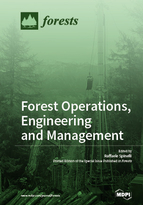Forest Operations, Engineering and Management
A special issue of Forests (ISSN 1999-4907). This special issue belongs to the section "Forest Inventory, Modeling and Remote Sensing".
Deadline for manuscript submissions: closed (31 January 2018) | Viewed by 148205
Special Issue Editor
Interests: forest operations; forest engineering; mechanization; logging; harvesting; system analysis; safety and health in forest operations; human factors studies; productivity; logging contractors; harvesting cost
Special Issues, Collections and Topics in MDPI journals
Special Issue Information
Dear Colleagues,
Forest operations represent the active element of productive forest management, where cost are incurred and revenues accrued. There is a great deal of scope for minimizing the former and maximizing the latter, and a very strong interest in doing so. As one of the many instances of human activity, forest operations shape the environment and affect the lives of people, for better or for worse. Efficiently managed forest operations offer the highest benefit and the lowest cost, in all fields: Financial, social and environmental. Increasing the efficiency of forest operations is the main goal of forest engineering, which represents a special sector of interest within the field of forestry, while maintaining a cross-disciplinary character, which is necessary for covering the many facets of forest work. Forest engineering often deals with practical issues that have a strong economic impact, concentrated within a relatively short time span. For this reason, the industry has always had a strong interest in forest engineering, which explains the close connection between scientists and economic operators. Supported by the industry, forest engineering research has always been very active, advancing technological progress in forestry.
The central role of forest engineering in modern forestry is demonstrated by the many sessions gathered under this general label, at the IUFRO 125th Anniversary Congress. The congress will offer a great opportunity for catching up with the latest results of forest engineering research, and it will represent a milestone in this field. The journal wants to seize this opportunity and is launching a Special Issue that will address current research about all main subjects in forest engineering, as presented at the IUFRO Congress.
Prospective authors are invited to contribute original manuscripts covering the following subjects:
innovative forest harvesting technology and techniques
system analysis and costing
forest biomass operations
product quality issues, including value recovery
wood supply chains
environmentally-friendly forest operations and reduced impact logging (RIL)
operation planning and logistics
reforestation and planting
safety and ergonomics
workforce issues
logger training and certification
logging business management and entrepreneurship
sustainability in forest operations
steep terrain harvesting
forest road planning and construction
This list is not exclusive, and prospective authors may submit manuscripts from any other fields of forest engineering. Submission can be structured to reflect any of the accepted paper types, namely: Research papers, short communications and review papers. Please click on the Instructions for Author button for more details regarding paper submission.
Prof. Raffaele Spinelli
Guest Editor
Manuscript Submission Information
Manuscripts should be submitted online at www.mdpi.com by registering and logging in to this website. Once you are registered, click here to go to the submission form. Manuscripts can be submitted until the deadline. All submissions that pass pre-check are peer-reviewed. Accepted papers will be published continuously in the journal (as soon as accepted) and will be listed together on the special issue website. Research articles, review articles as well as short communications are invited. For planned papers, a title and short abstract (about 100 words) can be sent to the Editorial Office for announcement on this website.
Submitted manuscripts should not have been published previously, nor be under consideration for publication elsewhere (except conference proceedings papers). All manuscripts are thoroughly refereed through a single-blind peer-review process. A guide for authors and other relevant information for submission of manuscripts is available on the Instructions for Authors page. Forests is an international peer-reviewed open access monthly journal published by MDPI.
Please visit the Instructions for Authors page before submitting a manuscript. The Article Processing Charge (APC) for publication in this open access journal is 2600 CHF (Swiss Francs). Submitted papers should be well formatted and use good English. Authors may use MDPI's English editing service prior to publication or during author revisions.
Keywords
-
Harvesting
-
Workforce
-
Technology
-
Simulation
-
Biomass






